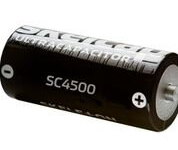Skeleton Technologies announced the launch of a new range of supercapacitors that are said to offer the highest level of energy density on the market. Through the use of patented graphene material, the new series boasts a capacitance of 4500 farads. The company claims that the closest competitor product has a capacitance of only 3400 farads.

Skeleton Technologies plans to use the SkelCap 4500 series to maximize opportunities in the heavy transportation and industrial markets where weight and space are at a premium. The new range has been designed for mass-market applications and the needs of systems engineers. The format has been developed to meet the industry standard of a 60 mm diameter cylindrical cell. Skeleton Technologies had previously offered prismatic cells, which are more compact in modular arrangements but more expensive to produce. Skeleton Technologies also claims to have achieved one of the lowest ESR (equivalent series resistance) levels on the market at 0.095 mΩ. This factor is crucial as it greatly increases the efficiency of the cells by reducing the amount of energy that is lost as heat.
In addition, the company aims to announce the first supercapacitor product for the hybrid truck market during next month.
In June 2015, Skeleton Technologies raised â¬9.8 million for ramping up production of graphene supercapacitors.
Graphene supercapasitors
Article talks about using graphene supercapasitors to "start vehicles after long storage". However, from what I read, supercapasitors do not hold charge for long.
Graphene Supercapacitors
Joseph Mitchener, since they are capacitors and not batteries, the terminal voltage begins to fall and continues falling exponentially as they discharge, so even a slight leakage current will slowly drop the voltage across the cap.
Some supercapacitor banks, e.g. 6 cells used to make up a 12v 'battery' will include a charge equalisation circuit which may well cause a slow discharge of the 'battery' over time. But this current would be quite small and easily offset by using e.g., a 12V solar battery charger to keep the system topped up.
Or just add the supercap 'battery' in parallel with a normal 'car' battery with plenty of capacity to keep the charge topped up.
Cheers!
Graphene Supercapacitors
Joseph Mitchener, more to the point you make, the problem with vehicle starting in cold weather or after a long down-time is that the initial cranking current required by the starting motor, combined with a normal lead-acid battery's increased internal resistance and hence reduced 'cranking amps' capability when cold, may combine to make starting difficult. By adding a supercap in parallel with the starting battery, its extremely low effective series resistance would enable much higher cold cranking current, making the vehile much easier to start in cold weather.
Also, if the engine had not been run for some time making fuel supply slower to become available to the engine, the extra capacity provided by the supercap would help get it started.
I hope that helps!